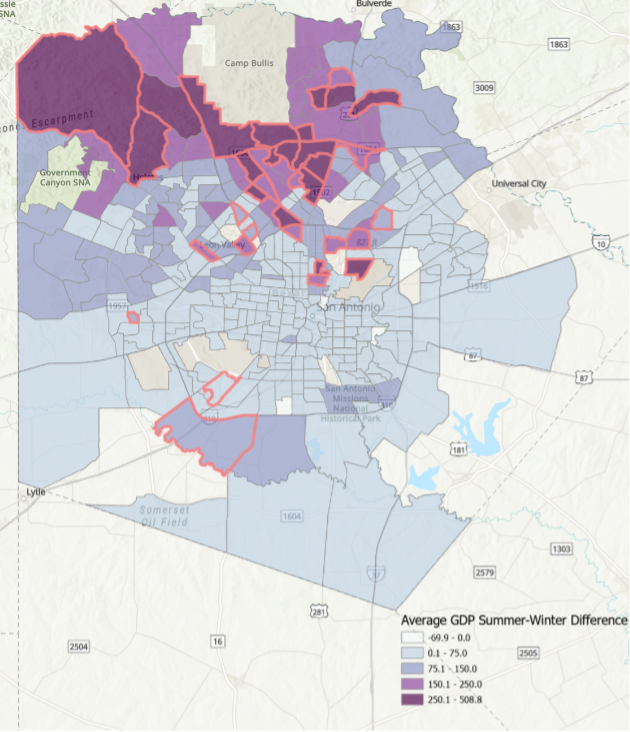
NOVEMBER 1, 2022 — Research conducted by state demographer and Director of the Institute for Demographic and Socioeconomic Research Lloyd Potter supports the implementation of a new tiered water rate structure by the San Antonio Water System. The new rate structure would result in customers being charged more equitably based on their usage and lead to greater water conservation in San Antonio.
The SAWS board will meet at 9 a.m. on Tuesday, November 1, to discuss a new tiered rate structure for both residential and commercial users that would charge high-water users a premium to encourage conservation. The proposed structure would result in reduced monthly water bills for about 83% of residential customers, as well as a reduction in all residential customers’ monthly wastewater bills.
Darrel M. Tremaine and Jay L. Banner at the University of Texas at Austin also contributed to the analysis, which was published in the journal Water in June.
 Figure 1 shows summer-winter differences in average gallons of water per day, census tracts, Bexar County, Texas, 2009-2016.
Figure 1 shows summer-winter differences in average gallons of water per day, census tracts, Bexar County, Texas, 2009-2016.“Our conclusion from this was that one strategy to try to reduce the demand and promote conservation that hopefully would result in reducing the overall cost of water is to put some sort of tiered structure in place,” Potter said.
The researchers compared residential water consumption between 2009 and 2015, using monthly billing data from SAWS. They focused on single-family households, examining the average gallons consumed per unit over a year. They looked at how usage changed during winter months, when water usage generally is down, and during summer months, the peak time for watering yards and filling swimming pools. The researchers then averaged this usage over the entire six-year period to reach their conclusion.
Additionally, Potter and his co-researchers analyzed the characteristics of the housing units they selected, using data from the Bexar County Appraisal District. They looked at the size of the lots of the houses, whether they had swimming pools and the location of the units in the city. They found that newer houses with swimming pools and higher appraisal values tended to consume more water, and they also sat in Census tracts associated with higher socioeconomic status, generally in the northern part of San Antonio near Loop 1604.
Conversely, neighborhoods with lower socioeconomic status tended to have relatively low water consumption.
Potter said the result of the city’s growing population and construction of new, larger houses in north San Antonio is greater demand for water, forcing SAWS to diversify its water supply by building new pipelines. That has led to the cost of water rising.
“The increased demand for water and the disproportionate consumption of housing units in certain areas of the city owned by people with higher socioeconomic status are what’s driving up the cost of water,” he said.
Meanwhile, people who live in older neighborhoods with a lower socioeconomic status are not consuming more water than they did 20 years ago, placing a disproportionate burden on those households, Potter said. They are essentially subsidizing access to large quantities of water for the larger, richer households.
“If the cost of water puts a disproportionate burden on some households as a function of the behavior of other households, there’s some equity issue that’s imposed there,” he said.
Studies conducted on tiered water rates in Australia, South San Francisco and Los Angeles have found they resulted in greater water conservation.
UTSA Today is produced by University Communications and Marketing, the official news source of The University of Texas at San Antonio. Send your feedback to news@utsa.edu. Keep up-to-date on UTSA news by visiting UTSA Today. Connect with UTSA online at Facebook, Twitter, Youtube and Instagram.
Move In To COLFA is strongly recommended for new students in COLFA. It gives you the chance to learn about the Student Success Center, campus resources and meet new friends!
Academic Classroom: Lecture Hall (MH 2.01.10,) McKinney Humanities BldgWe invite you to join us for Birds Up! Downtown, an exciting welcome back event designed to connect students with the different departments at the Downtown Campus. Students will have the opportunity to learn about some of the departments on campus, gain access to different resources, and collect some giveaways!
Bill Miller PlazaCome and celebrate this year's homecoming at the Downtown Campus with food, games, giveaways, music, and more. We look forward to seeing your Roadrunner Spirit!
Bill Miller PlazaThe University of Texas at San Antonio is dedicated to the advancement of knowledge through research and discovery, teaching and learning, community engagement and public service. As an institution of access and excellence, UTSA embraces multicultural traditions and serves as a center for intellectual and creative resources as well as a catalyst for socioeconomic development and the commercialization of intellectual property - for Texas, the nation and the world.
To be a premier public research university, providing access to educational excellence and preparing citizen leaders for the global environment.
We encourage an environment of dialogue and discovery, where integrity, excellence, respect, collaboration and innovation are fostered.